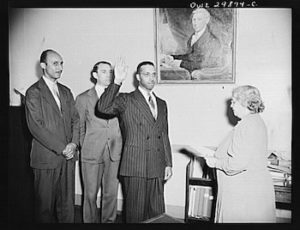
Martin A. Martin, (hand raised)
*Martin A. Martin was born on this date in 1910. He was a Black criminal and civil rights attorney.
Martin Armstrong Martin was born to Romey Orlando Martin and his wife Hattie Inge in Pittsylvania County, Virginia. The family included older sisters Costello Beatrice Martin and Willie Gladys Martin, older brothers, former Tuskegee Airmen pilot and banker Maceo Conrad Martin and Romey Orlando Martin, Jr., and a twin brother Andrew Inge Martin. He attended Ohio State University and then Howard University Law School. He became acquainted with fellow students and alumni Oliver Hill and Spottswood Robinson, who would later become his law partners.
Upon graduation in 1938 and attending the Virginia Bar, Martin established a private legal practice. His general practice included representing the Danville Savings Bank and black teachers in salary equalization lawsuits. Martin also came to head the local NAACP office. Martin first became involved in a nationally prominent case in September 1941, after black sharecropper Odell Waller for killing a white landlord in Gretna, Virginia. Martin learned that the grand jury and later the trial jury that convicted Waller included only white men who paid the poll tax.
On May 31, 1943, Martin became the first Black attorney in the U.S. Department of Justice Criminal Trial Division under Attorney General Francis Biddle. However, he did not like litigating cases involving aliens, so he resigned after less than a year. Soon after, he joined the Richmond law firm of Hill, Martin, and Robinson, his Howard classmates. Martin was the firm's criminal specialist. He attempted to defend the Martinsville Seven on appeal in 1949, assisted by Samuel W. Tucker, Roland D. Ealey, and Jerry Williams of Danville. They secured a limited stay of the execution date from Governor William M. Tuck and a writ of error from the Virginia Supreme Court.
Additional litigation in the U.S. District Court and Court of Appeals proved futile. The defendants were all executed on February 2 and 5, 1951. In the 1950s, the firm litigated various civil rights cases involving schools. He became the attorney of record in the 1958 case involving desegregating Richmond's public schools. Martin married twice. Maria Estelle Wright married him in 1942; they had no children when they divorced in 1947. He was survived by his second wife, Ruth Martin. Martin A. Martin died of a heart attack, aged 52, in his Richmond home on April 27, 1963, months after the U.S. Supreme Court decision in NAACP v. Button stopped the harassment of NAACP attorneys, which was another part of Massive Resistance.
He is buried in Roselawn Memory Gardens in Hanover, Virginia. The former law offices at 118 E. Leigh Street in Richmond became contributing buildings in the Jackson Ward Historic District. However, it was demolished as part of the Greater Richmond Convention Center project and replaced by a marker. In 1992, in a program entitled "Salute to Unsung Heroes," Martin was posthumously inducted into the Virginia Civil Rights Hall of Fame and one of the 33 student plaintiffs from the Prince Edward County school desegregation lawsuit.